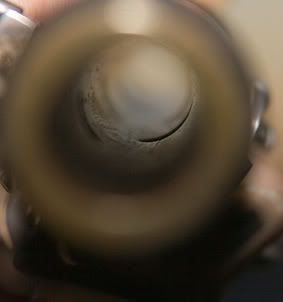I am totally new to the oboe. I play saxes and clarinets. I have just received my first working one - it was a cheap no-name from Ebay.
But I collect clarinets, and I think can recognise good workmanship when I see it - so when the oboe arrived, it was a bit more robust than I was expecting for the price.
I have asked about the origins of the oboe on the Oboe BBoard, but the thoughts so far is that it is definitely German made, and makers name in the frame are:
"Likely: Fritz Schuller
Possible: Markhardt, Poppe
Perhaps: Moenning"
I do know there are some experts here that know a thing or two about oboes who may not post on the oboe BB, so here are the same questions.
Any views on :
The maker
Wood used
Date of manufacture
Quality
Intended market of initial sale (student, intermediate, professional)
Value (serviced, sealing and tight)
The only marking is a serial number on all joints of 7016
The wood is dyed, with golden brown colour coming through wear areas on the body, but obvious inside. The bore is smooth.
Photos below











I have come across pictures of an instrument in UK labelled "Gebruder Monnig Wooden Oboe" on Ebay - http://cgi.ebay.co.uk/ws/eBayISAPI.dll?ViewItem&item=360098527518&ssPageName=STRK:MEWAX:IT
It has an identical case, though theirs is black. Mine below

It has the same profile keys (pointed over the pivots) as mine

And in the picture below, the right first finger touch piece is the same concave plate and the G# key appears same shape. The only difference is as below, mine has an adjustment screw on the small bridge over to the UJ and theirs did not, though the photos available were not great

Did the makers in the area use a common source for keys, and use the same cases as each other - or are these similarities significant?
Thanks for getting this far in the post, if you stuck with me!
So, to recap -
Any views on :
The maker
Wood used
Date of manufacture
Quality
Intended market of initial sale (student, intermediate, professional)
Value (serviced, sealing and tight)
Chris
But I collect clarinets, and I think can recognise good workmanship when I see it - so when the oboe arrived, it was a bit more robust than I was expecting for the price.
I have asked about the origins of the oboe on the Oboe BBoard, but the thoughts so far is that it is definitely German made, and makers name in the frame are:
"Likely: Fritz Schuller
Possible: Markhardt, Poppe
Perhaps: Moenning"
I do know there are some experts here that know a thing or two about oboes who may not post on the oboe BB, so here are the same questions.
Any views on :
The maker
Wood used
Date of manufacture
Quality
Intended market of initial sale (student, intermediate, professional)
Value (serviced, sealing and tight)
The only marking is a serial number on all joints of 7016
The wood is dyed, with golden brown colour coming through wear areas on the body, but obvious inside. The bore is smooth.
Photos below











I have come across pictures of an instrument in UK labelled "Gebruder Monnig Wooden Oboe" on Ebay - http://cgi.ebay.co.uk/ws/eBayISAPI.dll?ViewItem&item=360098527518&ssPageName=STRK:MEWAX:IT
It has an identical case, though theirs is black. Mine below

It has the same profile keys (pointed over the pivots) as mine

And in the picture below, the right first finger touch piece is the same concave plate and the G# key appears same shape. The only difference is as below, mine has an adjustment screw on the small bridge over to the UJ and theirs did not, though the photos available were not great

Did the makers in the area use a common source for keys, and use the same cases as each other - or are these similarities significant?
Thanks for getting this far in the post, if you stuck with me!
So, to recap -
Any views on :
The maker
Wood used
Date of manufacture
Quality
Intended market of initial sale (student, intermediate, professional)
Value (serviced, sealing and tight)
Chris
